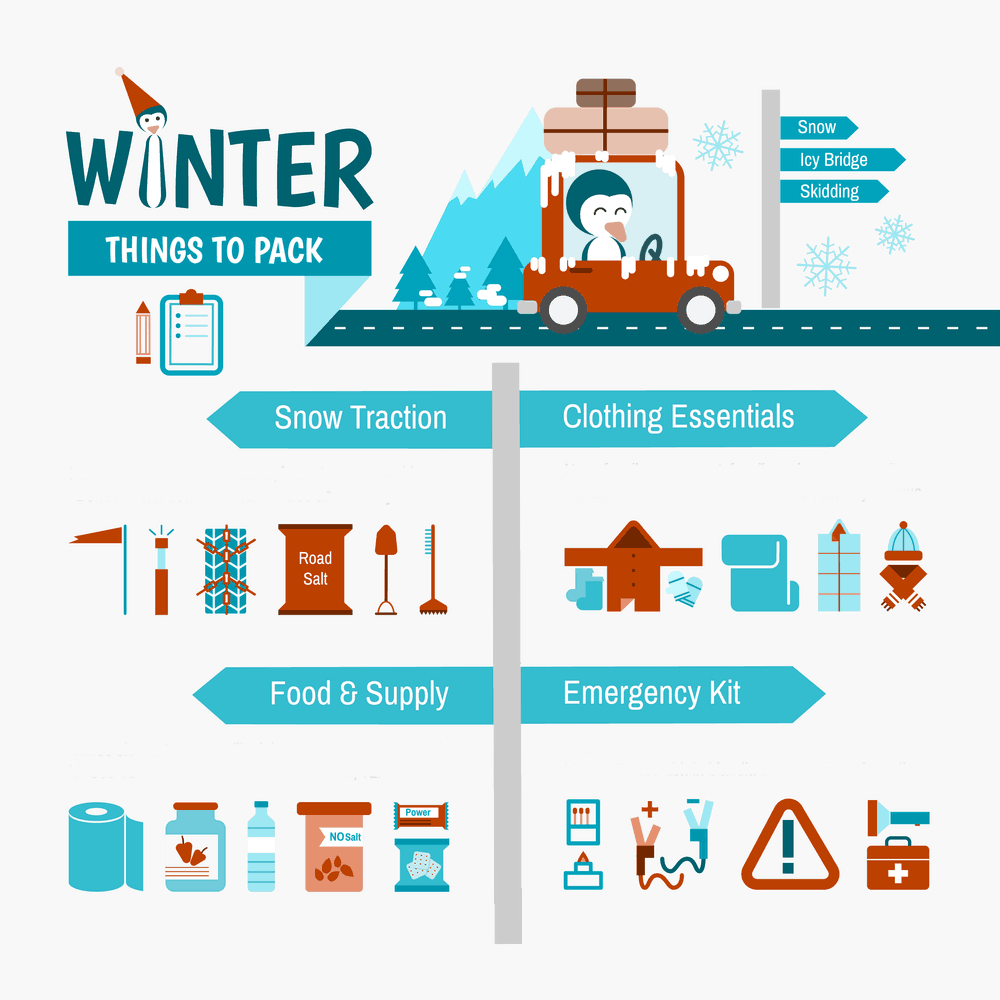Now that the weather is getting colder, it’s time to start thinking about how you’re going to protect your car. For many of us, a car is vital to our everyday life, which means that we can’t afford to be without it for long.

Unfortunately, as robust as most modern vehicles are, they can still struggle with the winter weather. Freezing temperatures can cause many issues to your car, which is why it’s imperative that you take the time to winterize it properly. So, with that in mind, we want to go over the best methods for preparing your vehicle this winter.
Why Winterize A Car?
Preventative maintenance is the first and most important step in ensuring a safe driving experience throughout winter. As many Canadians know, winter driving can be slow, cumbersome, and potentially dangerous and expensive if your vehicle is not well prepared. Many of the hazards of winter driving can be overcome when a vehicle is properly winterized.
10 Ways to Prepare Your Car for Winter Driving
Winter Tires
Even those who have all-wheel drive should pay close attention to their tires. If they aren’t well suited for colder weather, snow and ice, then having all four wheels spinning at once won’t make much of a difference.
Consider getting winter tires that are only seasonal or opt for all weather tires that are good all year round. If you have all season tires on your car already, you could think that they’ll handle the weather just fine. However, because they’re not designed specifically for colder weather, snow and ice, they won’t provide traction.
All weather tires are a good winter option if you live in a climate that gets little snow through the season. It’s important that, if you live in a climate that demands it, you get a new set for winter and then swap back to the old tires when spring arrives. Canadians living in milder climates, may be well-served by all-weather tires throughout the winter months.
The best thing to do is to go to a tire shop and consult with them about the right tires for your ride. Also, consider the kind of driving that you will be doing most. Will you be traveling on highways and backroads that may not get plowed as often, or will you stick to the city?
Tire Pressure
Tire tread wear is crucial for surviving this season, but it’s far from the only thing that matters. Tire pressure can affect how well you maneuver on the icy roads, which is why you always want to pay attention to it. Many people believe that the best thing to do is lower your tire pressure. The idea is that less air will make the tires spread out a little more, thus getting more traction in the process (similar to using snowshoes).
Unfortunately, that doesn’t work. In fact, you may be putting your car under more pressure, which can cause it to work harder and put more wear and tear. Since you need everything working in optimal condition, lowering your pressure is a bad idea.
Maintaining the manufacturer’s recommended tire pressure throughout the season is the best way to ensure that your tires are at their safest and best performing level.
Car Coolant
When it comes to keeping your vehicle’s engine running, nothing is quite as vital as coolant. It may seem unnecessary when the weather is so cold outside, but you have to remember that your engine will get extremely hot, regardless of the surrounding temperature.
Most coolant mixtures contain antifreeze to ensure that your vehicle maintains an optimal performance level, but you still have to check in and replace it every so often. It’s best to look at your owner’s manual. If you’re not sure, have a certified technician verify it as part of a preventative vehicle checkup routine. Overall, this is one element you can’t skimp on, lest it damage your engine and lead to some expensive repairs.
Car Battery
Even if your battery is relatively new, you will want to keep it clean and well maintained. Check for corrosion and wipe it down regularly.
Have your battery checked before the weather gets awful. It’s important to make sure it’s in good functioning order and to have it replaced if need be.
Since you may not be able to rely on other drivers to help you, having a jump starter could be a lifesaver during the winter months.
Window Washer Fluid
Your car uses a variety of liquids to help it perform well. Windshield wiper fluid is necessary for keeping your windows clean, but it can sometimes freeze in sub-zero temperatures. Thus, if you want to make sure that you don’t experience that problem, you should swap it out for a winterized version that has more antifreeze inside.
Install New Wiper Blades
Although new wiper fluid can help keep your windshield clean during the winter months, it won’t do much if your blades are old and cracked. Cold temperatures can wreak havoc on the rubber material of these items, which is why you want to inspect them before winter sets in. If necessary, upgrade to newer ones.
Car Engine Oil
The oil in your engine will handle winter weather, though not quite as well as synthetic oil. Switching to synthetic oil will provide better protection for your vehicle.
Check All Belts and Hoses
Belts and hoses are particularly susceptible to weather-related wear down as the temperature variation can cause cracks to form. Over time, they will worsen to the point where you could be looking at engine failure.
If you haven’t inspected your belts in a while, then you’ll want to have them checked before winter arrives. Also, be sure to look at them periodically throughout the season if possible. Some belts and hoses are hard to reach, so it may be a good idea to consult your certified technician to get a full diagnostic.
If necessary, replace them before the cold weather sets in. Any cracks that are already there will only get worse throughout the winter, so you want to make sure that you can avoid any significant problems (and repair bills that come with them).
Get Your Car Washed and Waxed
While snow isn’t going to do much damage to your car’s exterior, all of the dirt, grime, and other debris can. Whether its road salt or some other element used to provide traction, your car can get dirty really fast.
Waxing your car before winter comes is an excellent way to help keeping all of the salt and other dirt from damaging your paint. If you are going to wax, then you’ll want to clean the car thoroughly first. Doing this will ensure that the wax bonds better and stays on longer.
Why Pack An Emergency Kit For Your Passengers?
One of the best things to pack in your car during the winter months is an emergency kit for both you and your passengers. Even if you only drive by yourself most of the time, there may be situations where you’re driving other people (i.e., heading to and from a family member’s house, or going to a party). Thus, you want to be sure that you’re ready to accommodate everyone that may be in your vehicle when disaster strikes.

Winter Emergency Kit
As we mentioned, having a kit inside your car can be a lifesaver, especially if you plan on traversing some lonely, unplowed roads. The worst thing that could happen is that you get stuck in a snow bank, and depending on where you live, it could be a while before help arrives.
Also, consider if you’re parked in a semi-remote area, and your car doesn’t start. You may have to wait for a long time before you can get a jump, which is another reason to have an emergency kit on hand throughout the season.
Although there may be additional items that you want to include, this list is a pretty solid foundation for you to use:
- Winter Work Gloves – if you have to get out and do work on your car, you want to make sure that your hands stay warm. Standard gloves won’t provide as much grip, and they could get torn apart.
- Headlight – working at night is very challenging, and your car’s headlights won’t do much to illuminate your engine. Plus, having a light mounted to your head frees both of your hands, which is necessary if you’re by yourself.
- Windshield Scraper With Broom – most people think of having a windshield scraper for ice and snow, but what happens if you have several inches? Also, what about the rest of your car? Having a broom ensures that you can remove all of the snow without getting your hands and arms wet and snowy.
- Winter Emergency Car Shovel – if you do get stuck in a snowbank, having a shovel will come in handy.
- Air Compressor – once you fix the flat, you have to replace it with a fully inflated spare tire. Having this device with you will be a lifesaver should you happen to find that your spare isn’t as inflated as it needs to be.
- Lightweight Winter Blanket – if you do wind up having to spend a couple of hours waiting for help, then you want to be able to stay warm. Ideally, you’ll have multiple blankets for any people riding with you.
- Extra Clothes – along with the hat, having additional layers can ensure that you don’t freeze while waiting for the tow truck. Again, have multiple pairs for anyone else in the vehicle.
- First Aid Kit – since you never know what can happen, you need to make sure that you’re ready for anything. Even a scrape or minor cut can become a problem if left untreated.
- Leatherman Pocket Tool – these devices can come in handy, especially if you have to do some on-the-road repairs. Make sure that it comes with screwdrivers, just in case.
- Emergency Flares – when the weather gets intense, it will be hard for tow trucks and other emergency vehicles to see you. Having flares will improve your chances of getting spotted.
- Snack Food – if you spend a few hours in your car waiting for help, you don’t want your stomach to be a problem along the way. Make sure to rotate the food and keep items that don’t need preparation, like granola bars, protein bars, and nuts.
- Fluorescent Distress Flag – like having flares, this item will make you more visible. Better yet, it won’t run out of fuel.
- Bag of Rock Salt or Kitty Litter – as you may know, salt helps the snow melt. Kitty litter works well at providing traction if you’re stuck. Either or both of these can help you get your car out of tough situations.
Conclusion
If you’ve never winterized your car before, it’s never too late to start. Sure, you may have lasted a few winters already, but the extra wear and tear on your vehicle will add up over time.
Now is the perfect time to start making these changes and inspecting the various internal elements of your vehicle and get it fixed before the weather gets too severe.
If you’ve ever been in a winter emergency with your car and I didn’t address it here, please help us improve this article! Let us know what’s missing and we’ll get it added to the article.
If you’re in Canada, consider talking with a Certified Technician at OK Tire about winter driving, especially the topic of all-season tires vs snow tires. Here’s a little more info about OK Tire:
- As one of the largest independent tire and auto service retailer in Canada, OK Tire Certified technician have the experience and knowledge to help you make the right decisions for your vehicle, no matter what the year, make or model.
- With over 300 locations coast to coast, OK Tire is 100% Canadian owned and operated.
- Customers can count on national support and the personal service of a local owner who lives in, shops in, and supports their community.
- To find out more about OK Tire, please visit oktire.com.
